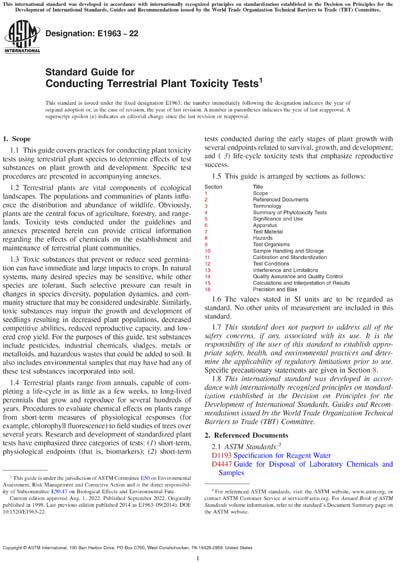Most recent
ASTM E1963-22
Standard Guide for Conducting Terrestrial Plant Toxicity Tests
1.1This guide covers practices for conducting plant toxicity tests using terrestrial plant species to determine effects of test substances on plant growth and development. Specific test procedures are presented in accompanying annexes.
1.2Terrestrial plants are vital components of ecological landscapes. The populations and communities of plants influence the distribution and abundance of wildlife. Obviously, plants are the central focus of agriculture, forestry, and rangelands. Toxicity tests conducted under the guidelines and annexes presented herein can provide critical information regarding the effects of chemicals on the establishment and maintenance of terrestrial plant communities.
1.3Toxic substances that prevent or reduce seed germination can have immediate and large impacts to crops. In natural systems, many desired species may be sensitive, while other species are tolerant. Such selective pressure can result in changes in species diversity, population dynamics, and community structure that may be considered undesirable. Similarly, toxic substances may impair the growth and development of seedlings resulting in decreased plant populations, decreased competitive abilities, reduced reproductive capacity, and lowered crop yield. For the purposes of this guide, test substances include pesticides, industrial chemicals, sludges, metals or metalloids, and hazardous wastes that could be added to soil. It also includes environmental samples that may have had any of these test substances incorporated into soil.
1.4Terrestrial plants range from annuals, capable of completing a life-cycle in as little as a few weeks, to long-lived perennials that grow and reproduce for several hundreds of years. Procedures to evaluate chemical effects on plants range from short-term measures of physiological responses (for example, chlorophyll fluorescence) to field studies of trees over several years. Research and development of standardized plant tests have emphasized three categories of tests: (1) short-term, physiological endpoints (that is, biomarkers); (2) short-term tests conducted during the early stages of plant growth with several endpoints related to survival, growth, and development; and (3) life-cycle toxicity tests that emphasize reproductive success.
1.5This guide is arranged by sections as follows:
1.6The values stated in SI units are to be regarded as standard. No other units of measurement are included in this standard.
1.7This standard does not purport to address all of the safety concerns, if any, associated with its use. It is the responsibility of the user of this standard to establish appropriate safety, health, and environmental practices and determine the applicability of regulatory limitations prior to use. Specific precautionary statements are given in Section 8.
1.8This international standard was developed in accordance with internationally recognized principles on standardization established in the Decision on Principles for the Development of International Standards, Guides and Recommendations issued by the World Trade Organization Technical Barriers to Trade (TBT) Committee.
ASTM International [astm]

